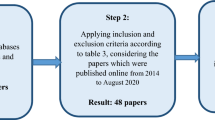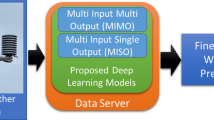Abstract
In this paper, we aim to develop computational intelligence approaches for wind profile prediction. Specifically, we focus on two aspects in this work. First, we investigate the missing value recovery for wind data. Due to the complexity of data collection in such processes, wind data normally include missing values. Therefore, how to effectively recover such missing values for learning and prediction is an important aspect for wind profile prediction. Second, we develop an ensemble learning approach based on multiple neural network models. Our proposed method uses a new strategy based on the temporal information to assign the weights for each model dedicated for wind profile prediction to achieve better prediction performance. Various simulation studies and statistical testing demonstrate the effectiveness of our approach.







Similar content being viewed by others
References
Airport station (ASOS/AWOS). [online], Available: http://climate.sdstate.edu/airport/surface/archive.asp
Office of Electric Transmission and Distribution (2003) United State Department of Energy, Grid 2030: a national version for electricity second 100 years
U.S. Department of Energy (2008) The smart grid: an introduction; [online], Available: http://www.oe.energy.gov/smartgrid.htm
Arteaga F, Ferrer A (2005) Framework for regression-based missing data imputation methods in online mspc. J Chemom 19(8):439–447
Balouktsis A, Tsanakas D, Vachtsevanos G (1986) Stochastic simulation of hourly and daily average wind speed sequences. Wind Eng 10(1):1–11
Beyer HG, Degner T, Haussmann J, Hoffman M, Rujan P (1994) Short term prediction of wind speed and power output of a wind turbine with neural networks. In Proceedings the second European congress on intelligent techniques and soft computing
Breiman L (1996) Bagging predictors. Mach Learn 24(2):123–140
Breiman L (1996) Bagging predictors. Mach Learn 24(2):123–140
Breiman L (2001) Random forests. Mach Learn 45(1):5–32
Farhangfar A, Kurgan LA, Pedrycz W (2007) A novel framework for imputation of missing values in databases. IEEE Trans Syst Man Cyber Part A Syst 35(5):692–709
Freund Y, Schapire RE (1996) Experiments with a new boosting algorithm. In: Proceedings of international conference machine learning, pp 148–156
Freund Y, Schapire RE (1997) A decision-theoretic generalization of online learning and application to boosting. J Comput Syst Sci 55(1):119–139
Haykin S (1999) Neural networks: a comprehensive foundation. 2nd edn. Prentice Hall, Upper Saddle River, New Jersey
He H, Shen X (2007) A ranked subspace learning method for gene expression data classification. In: Proceedings of international conference artificial intelligence, pp 358–364
He H, Starzyk JA (2006) A self-organizing learning array system for power quality classification based on wavelet transform. IEEE Trans Power Deliv 21:286–295
Ho TK (1998) Random subspace method for constructing decision forests. IEEE Trans Pattern Anal Mach Intell 20(8):832–844
Ho TK (2003) Multiple classifier combination: lessons and next steps. Hybrid Methods Pattern Recognit (2):219–230
Ipakchi A, Albuyeh F (2009) Grid of the future. IEEE Power Energy Mag, pp 52–62
Jacobs RA, Jordan MI, Nowlan SJ, Hinton GE (1991) Adaptive mixtures of local experts. Neural Comput 3(1):79–87
Jordan MJ, Jacobs RA (1991) Hierarchical mixtures of experts and the em algorithm. Neural Comput 6(2):79–87
Jordan MJ, Xu L (1995) Convergence results for the em approach to mixtures of experts architectures. Neural Netw 8(9):1409–1431
Kamal L, Jafri YZ (1997) Time series models to simulate and forecast hourly averaged wind speed in Quetta, Pakistan. Sol Energy 61(1):23–32
Kariniotakis G, Stavrakakis G, Nogaret E (1996) A fuzzy logic and neural network based wind power model. In: Proceedings of the 1996 European Wind energy conference, pp 596–599
Kariniotakis G, Stavrakakis G, Nogaret E (1996) Wind power forecasting using advanced neural network models. IEEE Trans Energy Conver 11(4):762–767
Kittler J, Hatel M, Duin RPW, Matas J (1998) On combining classifiers. IEEE Trans Pattern Anal Mach Intell 20(3):226–239
Krogh A, Vedelsby J (1995) Advances in neural information processing systems, volume 7, chapter Neural network ensembles, cross validation and active learning. MIT Press, pp 231–238
Kuncheva LI, Whitaker CJ (2003) Measures of diversity in classifier ensembles and their relationship with the ensemble accuracy. Mach Learn 51:181–207
Lam L (2000) International workshop on multiple classifier systems, lecture notes in computer science, volume 1857, chapter classifier combinations: implementations and theoretical issues. Springer, pp 78–86
Lin L, Eriksson JT, Vihriala H, Soderlund L (1996) Predicting wind behavior with neural networks. In: Proceedings of the 1996 European Wind energy conference, pp 655–658
Little RJA, Rubin DB (2002) Statistical analysis with missing data. 2nd edn. Wiley-Interscience, Hoboke
Littlewood B, Miller D (1989) Conceptual modeling of coincident failures in multiversion software. IEEE Trans Softw Eng 15(12):1596–1614
Myrtveit I, Stensrud E, Olsson E (2001) Analyzing data sets with missing data: an empirical evaluation of imputation methods and likelihood-based methods. IEEE Trans Softw Eng 27(11):999–1013
Opitz D, Maclin R (1999) Popular ensemble methods: an empirical study. J Artif Intell Res 11:169–198
Politis DN (2003) The impact of bootstrap methods on time series analysis. Stat Sci 18(2):219–230
Rosen B (1996) Ensemble learning using decorrelated neural networks. Conn Sci 8(3/4):373–383
Rubin DB (1987) Multiple imputations for nonresponse in surveys. Wiley, New York
Rubin DB (1996) Multiple imputation after 18+ years. J Am Stat Assoc 91(434):473–489
Sarle WS (1998) Proceedings of JCIS, volume 2, chapter prediction with missing Inputs, pp 399–402
Sfetsos A (2000) A comparison of various forecasting techniques applied to mean hourly wind speed time series. Renewable Energy 21(1):23–35
Starzyk J, Zhu Z (2002) Software simulation of a self-organizing learning array system. The 6th IASTED international conference artificial intelligence & Soft Comp. (ASC 2002)
Starzyk JA, Zhu Z, He H (2003) Self-organizing learning array and its application to economic and financial problems. In: Proceedings of joint conference information systems
Strike K, Emam KE, Madhavji N (2001) Software cost estimation with incomplete data. IEEE Trans Softw Eng 27(10):890–908
Theodoridis S, Koutroumbas K (2006) Pattern recognition. 3rd edn. Elsevier, Amsterdam
Wang H, Fan W, Yu P, Han J (2003) Mining concept-drifting data streams using ensemble classifiers. In: Proceedings of ACM SIGKDD Conference (SIGKDD’03), pp 226–235
Wolpert DH (1992) Stacked generalization. Neural Netw 5(2):241–259
Zhu Z, He H, Starzyk JA, Tseng C (2007) Self-organizing learning array and its application to economic and financial problems. Inform Sci 177:1180–1192
He H, Garcia EA (2009) Learning from imbalanced data. IEEE Trans Knowl Data Eng 21(9):1263–1284
Acknowledgments
This work was supported in part by the National Science Foundation (NSF) under CAREER Grant ECCS 1053717 and National Natural Science Foundation of China (NSFC) under grant 50937002.
Author information
Authors and Affiliations
Corresponding author
Additional information
This work was performed when Yi Cao was a Visiting Scholar at the Department of Electrical, Computer, and Biomedical Engineering at the University of Rhode Island.
Rights and permissions
About this article
Cite this article
He, H., Cao, Y., Cao, Y. et al. Ensemble learning for wind profile prediction with missing values. Neural Comput & Applic 22, 287–294 (2013). https://doi.org/10.1007/s00521-011-0708-1
Received:
Accepted:
Published:
Issue Date:
DOI: https://doi.org/10.1007/s00521-011-0708-1




